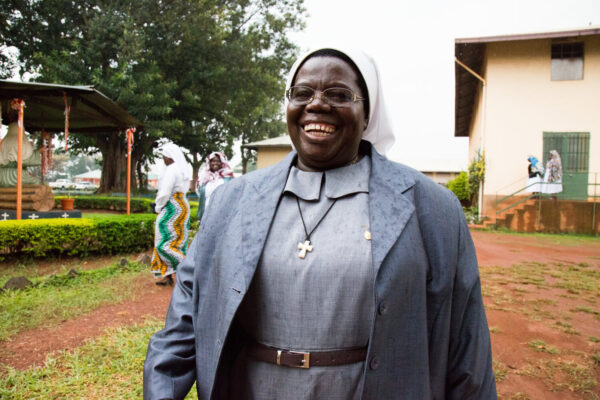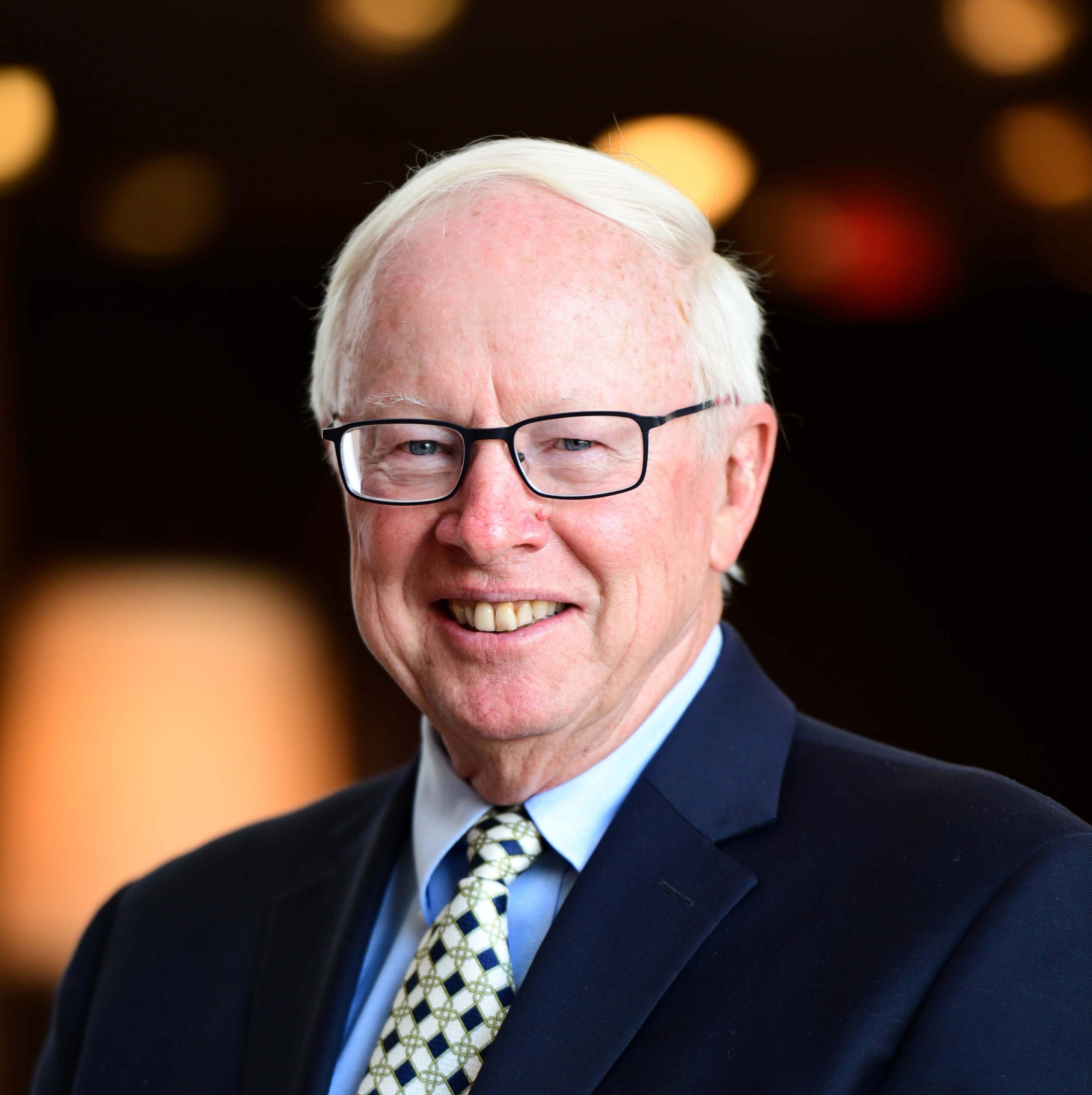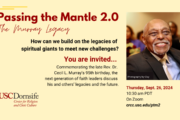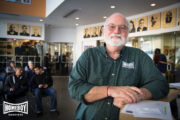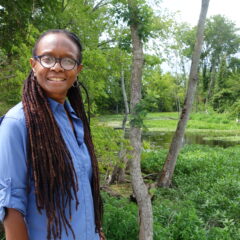This article was originally published by Religion Unplugged, with the support of CRCC’s global project on engaged spirituality.
ATIAK, Uganda— Studying religion all of my academic career has made me into a bit of a skeptic. There is so much despicable behavior by people who purport to be God’s representatives.
My cynicism has been tempered recently, however, by hanging around Catholic sisters—or nuns, as they are frequently called. For a five-year period, I was involved in evaluating the global programs of sisters funded by a large secular foundation. This responsibility took me all over Africa, Rome to a gathering of 700 leaders of religious orders around the world and meetings with sisters in the United States, Mexico and elsewhere.
The number of Catholic sisters in the U.S. has fallen dramatically, from 180,000 in 1965 to fewer than 50,000 today. But in Africa, the number of sisters and postulants for religious orders is booming. In fact, some countries have needed to put a lid on applicants in order to make certain that sisters-to-be receive proper education and formation.
Prior to the COVID-19 lockdown, I found myself in Uganda at a convening of about 100 sisters from East Africa. One afternoon, we went to visit a nearby project run by sisters. It was a facility for severely handicapped children. These kids were the castoffs of society; many had twisted bodies and had to be carried; others were victims of congenital issues and unable to speak.
As I went from room to room, then joined other participants for a group meeting, my heart was broken for these kids, but I was also inspired by the dignity granted to each child by the sisters caring for them. The children were vivacious, responsive, eager to be engaged.
When I returned to the convening I was attending, I sought out Sister Rosemary Nyirumbe, one of the speakers. She had received CNN’s Hero Award in 2007 for her work with child soldiers and victims of sexual exploitation who had suffered under Joseph Kony, the rebel commander of the Lord’s Resistance Army (LRA), which was responsible for the deaths of thousands of people in Northern Uganda beginning in the mid-1980s. The LRA abducted at least 30,000 children during its crusade against the government of Uganda. By 2006, 2 million people had been displaced from their homes.
In 2001, Sister Rosemary was stationed at St. Monica’s convent in Gulu, Uganda, by her religious order, the Sisters of the Sacred Heart of Jesus. At night, 40,000 children in Northern Uganda would leave their villages in the bush and flee to city centers where they would sleep, hoping to escape the raids of the LRA. Some 13,000 children would enter Gulu each night, and up to 500 would sleep at the compound of St. Monica’s.
As Sister Rosemary interacted with these children, she realized how traumatized they were. One of the brainwashing tactics of the LRA was to force abducted children to kill fellow villagers, parents and even their own siblings, as a way of creating total obedience so they would join the rebel soldiers on raids of other communities. Young girls were given as “wives” to the rebel leaders. Arms and hands were chopped off if orders were not followed. Some of this horror was documented in the video, Invisible Children, which went viral as soon as it was released.
Sister Rosemary’s vows and the mission of her congregation—to serve the poorest of the poor, regardless of the risks—compelled her to post flyers and run radio ads to invite children, especially girls, to flee their abductors and join them at St. Monica’s convent. Hundreds of girls came, often with the babies that had been born from rapes by their captors. Sister Rosemary knew that these young women needed their dignity to be restored. Not only did they need a place to sleep, they needed skills so they could be self-supporting. Sant’Egidio, a lay Catholic organization in Rome and the only donor that didn’t ask Sister Rosemary for a strategic plan, supplied food, mattresses and blankets for the so-called “night commuters.”
She started teaching the girls sewing skills on a few Singer sewing machines. In time, more were purchased with help from various donors. Then she started a catering service so the girls could learn to cook as well as earn money. And because of the number of girls who had babies to care for, she started a kindergarten so the girls would have time to sew, cook and go to school.
All of these undertakings required money, and one of the key donors was a lawyer from Oklahoma, Reggie Whitten, whose son had been killed in a drug-related motorcycle accident. In his son’s memory, Whitten worked with various friends to start Pros for Africa, bringing athletes and later professionals of all backgrounds to support and fund Sister Rosemary’s evolving projects.
Traveling to Atiak
When I asked Sister Rosemary whether she had any new projects, she said: “Come with me to Atiak.” So, when our conference ended, we drove from Entebbe to St. Monica’s in Gulu, where I overnighted in a thatched guesthouse. The next day, after morning worship in the chapel, we headed to Atiak, another few hours north, near the border with South Sudan. Along the way, Sister Rosemary told me that there were numerous orphans and migrants living in Atiak because of the South Sudanese civil war. Furthermore, the LRA had earlier ravished Atiak, killing dozens of residents and claiming it as their territory.
At first, she thought she would simply bring girls from Atiak to St. Monica’s in Gulu, but when 100 girls showed up for the first meeting, she realized it would be much better to create a compound for the people she wanted to serve to live there. So in 2009, using the $30,000 she had received as prize money from CNN, Sr. Rosemary started Sewing Hope Children’s Village in Atiak, modeled on St. Monica’s Girls Tailoring Centre in Gulu.
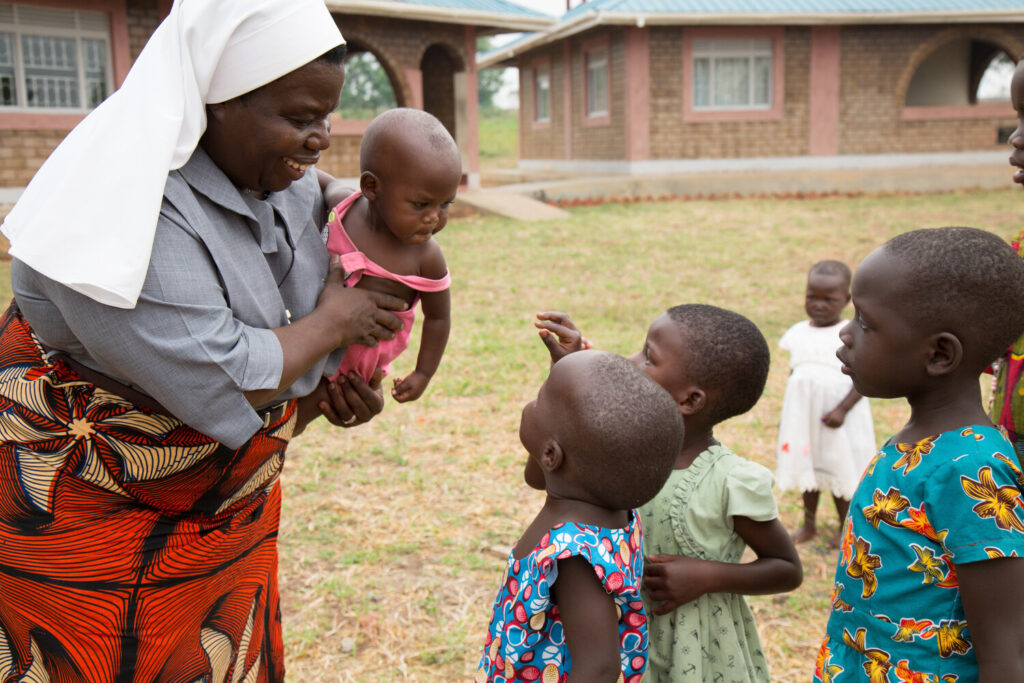 Sister Rosemary in Atiak, Uganda. Photo by Donald Milller.
Sister Rosemary in Atiak, Uganda. Photo by Donald Milller.
When we pulled into the yard, young children ran to Sister Rosemary, clinging to her long skirt. She had brought candy with her, which created chaos, so she had the children line up as she sat down and gave each child a treat. While this was going on, I turned to see that there were a number of newly constructed brick houses in a large circle, village style, surrounding a large open space. When the children had eaten their candy, they were eager to show me their individual homes. Each one had two bedrooms—one for girls, another for boys—and a small kitchen and room for the housemother who lived with the children.
Construction of the compound was moving forward on faith. While the houses had been built, on the periphery there were two partially completed structures. One was a school, and the other was a medical clinic. In the yard was a brick-making machine. In Rwanda, I had seen a similar machine: Workers shovel wet soil into the top of it and a few moments later a highly compressed brick pops out the lower unit. Clearly, tens of thousands of bricks had been made by this machine, given the complex of buildings that were part of the Sewing Hope Village.
We entered an office made with bricks from the same machine and a solar panel on its thatched roof. Over tea, Sister Rosemary told me about her vision for the future. She had purchased a 100-acre farm with the goal that the children would not go hungry. She also had a parcel on the main road, where she hoped to build a petrol station to provide income for the village. And there, of course, was work to be done to finish the school, medical clinic and a play area for the kids.
When I recently interviewed Sister Rosemary through Zoom, she was at the University of Oklahoma, writing a dissertation for a Ph.D. in education. Because of the pandemic, funding for the Atiak project had dried up—for the moment. She had not been able to finish the school or the clinic. However, she had an indomitably positive attitude.
“I have never started a project because I had the money,” she said. “If it is God’s will, the project will be finished.”
The farm, however, was doing great. And the school would be functioning, she said, had the pandemic not compelled a lockdown of schools.
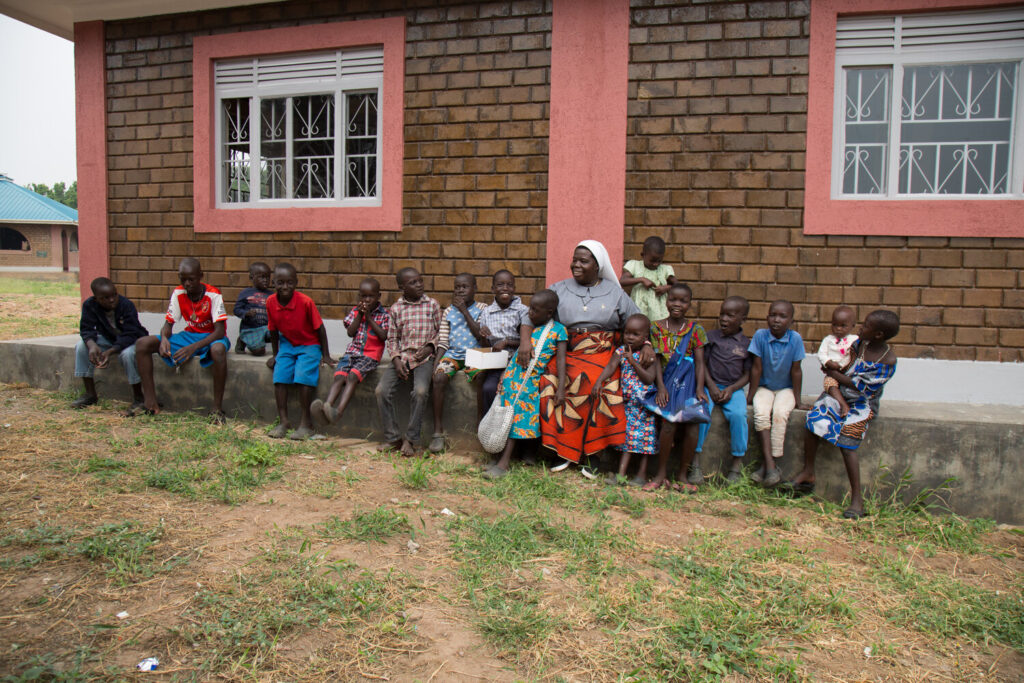 Sister Rosemary with children in Atiak, Uganda. Photo by Donald Miller.
Sister Rosemary with children in Atiak, Uganda. Photo by Donald Miller.
Becoming a Nun
Sister Rosemary is the seventh of eight children. The first five were born in the Democratic Republic of the Congo (then Zaire), but her parents moved to Paidha in northern Uganda for the birth of the last three. Her father was a skilled carpenter, trained in the DRC. Her mother was a housewife and also very active in politics. Both were illiterate—though, based on Sister Rosemary’s doctoral work in education, she no longer would use that term, given her parents’ cultural and political literacy. For her mother, in particular, education was a high priority for all the children, including the girls. Her father was more provincial and reluctant to support his daughters’ education, but yielded to his wife’s insistence when she threatened to brew local beer and sell it to pay for the girls’ tuition.
When Sister Rosemary was 5 years old, she went to live with her oldest sister and husband, both of whom were teachers. Rosemary’s task was to take care of the babies, and she credits this experience with her love for children. At age 13, she returned to her parent’s household and was clearly influenced by her mother’s extroverted nature. Meanwhile, her father was the quiet one in the house and preferred to play a local stringed instrument at night, guarding the door so his children would not sneak out and get in trouble in town.
Rosemary was a leader at school, good at sports and well protected by her older brother, who taught her to stand up for her rights. Walking five minutes every morning to the local church for Mass was part of her regular habit. But everyone was shocked when, at age 15, she declared that she wanted to enter a convent. Her sister Martha had the same intentions but was told by their parents that she needed to marry and get a job so that she could pay the tuition of the younger siblings.
 Sister Rosemary meets with other Catholic sisters in Gulu, Uganda. Photo by Donald Miller.
Sister Rosemary meets with other Catholic sisters in Gulu, Uganda. Photo by Donald Miller.
After some debate, Rosemary decided to enter the Sisters of the Sacred Heart of Jesus in Moyo, also in northern Uganda. She was attracted to the charism (in this context, charism means “spiritual mission”) of this religious order, which says, in part:
“In our apostolate, we are driven by the sacrifice of Christ, to go to the poorest of the poor, often in difficult places where others would not be willing go. We work under difficult conditions with little or no pay, to restore the dignity of the people, and we are fully aware that in responding to our call to apostolic service, we shall need to risk, to suffer, to meet difficulties, frustration and weariness.”
Clearly Sister Rosemary got what she signed up for by joining this indigenous order of African sisters.
A Sister’s Journey
From an outsider’s view, such as my own—I’m a somewhat wayward Episcopalian—the decision to be a sister is a fairly irrational thing to do. Why would one want to take a vow of poverty, give up sex (the vow of chastity) and be unquestioningly obedient? In probing this question with Sister Rosemary in three separate interviews, I’d say the answer, for her, boils down to this: At age 15 she felt a call from God to live a life of service, especially service to the poor. This call, however, meant that she needed to undergo what Catholics call “formation.” For example, she needed to be up by 5:30 am for morning prayers, which was a real struggle. And as a strong-willed girl, obedience was also a challenge. In fact, in one of my interviews I asked her if she was a “visionary rebel,” and she agreed. But on the issue of chastity, she said that God gave her hundreds of children to care for, so she had no complaints.
Shortly after taking final vows, she was sent by her community to serve in the maternity ward of a nearby hospital, and a year later she entered the Kalongo School of Nursing and Midwifery in Gulu, where Dr. Ambrosoloi asked her to be his assistant in surgery. That experience later paid great dividends when Sr. Rosemary was forced to stich up rebel soldiers as well as their victims. In 1981, she was sent back to Moyo, the location of the Ugandan motherhouse for her order, to run the dispensary at a medical clinic. Filled with energy, she also helped update their orphanage, the Moyo Babies’ Home. Then, after three years, she was transferred to Adjumani, about 20 miles south of Moyo, to run a medical clinic. However, she was itching to finish her secondary school studies, since she only had the midwife certificate at this point. So, after a year in Adjumani, she left for the Sacred Heart Secondary School in Gulu, arriving there at the end of 1986.
This was a tumultuous period in Gulu because of the violence of the Lord’s Resistance Army, so she had to quit taking classes in 1988. The next year, she and her fellow sisters left Gulu and went to the motherhouse in Moyo. Sister Rosemary’s leadership skills had been recognized by her community and, even though she was only 33 years of age, she was appointed as the “superior” of her order in Uganda. In this regard, she was part of a trailblazing movement in Africa in which indigenous Africans were exercising local leadership over their religious orders.
Committed to furthering her education, Sister Rosemary entered an undergraduate program during this period at Uganda Martyrs University, where she received her undergraduate degree in development studies and ethics in 1991, followed by a Master’s degree in the same field from the same university. These years of study, the leadership of her religious order, and the training in midwifery and surgery were the preparation for her next big step, which was her assignment in 2001 to return to Gulu, where she established St. Monica’s Vocational School for Girls in response to the violence spawned by Joseph Kony and the Lord’s Resistance Army.
What Motivates People Like Sister Rosemary?
I already mentioned that Rosemary experienced a call to spiritual life as a young woman. But what sustains her, given the trauma that she experienced? Not only was her life threatened multiple times by the LRA, but she dealt repeatedly, one on one, with young women who had been raped, humiliated and sometimes forced to kill others—even their next of kin. This takes a toll on a person, and Sister Rosemary said that at times, especially when she was young—she is now 64—she experienced both personal and vicarious trauma from working with women who had experienced the unimaginable.
Having read a lot of psychohistory, I’m tempted to reduce this answer regarding her resilience to a few key psychological variables. Sister Rosemary came from a very stable family upbringing. Her mother was a great role model, being active in politics. Also, her parents had welcomed refugees from Congo into their home when she was a child, setting an excellent example of sacrifice and hospitality. And, constitutionally, she inherited some very good genes, including a strong, extroverted personality that always catapulted her into leadership, even as a child. But there is something more going on, which takes us into the mystical realm of religion.
When I first encountered Catholic sisters, I found the idea of “formation” to be an alien concept, but the more I think about it the more logical it seems. Formation is simultaneously a period, usually five to seven years, when one internalizes the charism of the religious order, but it is also a period of discernment during which one decides whether a life of spiritual practice and devotion is really the life for oneself. For Sister Rosemary, the commitment to her vocation as a sister involved deciding that she would put service to others above her own ego needs. In short, she would live for others, and for her this meant serving the poorest of the poor, the most vulnerable in her society.
The irony, she told me recently, is that in her vow of poverty she feels incredibly rich, because she needs nothing.
“This has been my journey: complete trust that I will be taken care of by God, complete trust that I will lack nothing, complete trust that I don’t need to surround myself with many things,” she said.
It is her vow of poverty that gives her a lightness of being–a joy that is recognized by everyone who meets her. In some ways, she embodies a very Buddhist idea that suffering is the result of desire and the path to true happiness is to give up all wants and needs.
The other dimension of the religious life is spiritual practice—prayer, meditation, worship, confession, fasting and retreats, including spiritual direction with a wise mentor. The anthropologist Tanya Luhrmann observes in a recent book that we don’t worship because we believe; rather, we believe because we worship. It is in the acts of worship, broadly defined, that God (the invisible Other) speaks to the individual. In this regard, religion is not a logical exercise. It is a choice, rooted in spiritual practice, that one contextualizes and gives meaning to by appropriating the words and symbols of a religious tradition. In the case of Sister Rosemary, she calls herself a “traditional Catholic,” even though she is quite open-minded when it comes to other faith traditions and some of the more progressive views of Pope Francis.
As I said previously, there is something highly irrational about committing oneself to a religious vocation—unless one is called to do so. Meeting the daily challenges that Sister Rosemary experienced in her ministry to traumatized girls is not sustainable without some form of daily spiritual renewal. In addition to daily prayers, Sister Rosemary said that every day after the Rosary she says 50 times, “Father, you are most provident.” By this she means, God will provide. And this is why she believes that God will complete the work that she began in Atiak for the Children’s Village.
Now, of course, one can argue that this is a false hope, an “illusion” as Sigmund Freud thought. This is the cynic’s view. But according to anthropologist Luhrmann, it is in spiritual practices such as Sister Rosemary’s prayer that “God talks back” to people. As previously stated, religious faith is not a matter of logical deduction. It is, finally, an experience of the “invisible Other,” a provident God, that enables someone like Sister Rosemary to be a hopeful visionary. She lives, not for herself, but to see the transformation of girls who went from hopelessness and traumatized numbness to a new life.
In my last conversation with Sister Rosemary, she told me about a recent Zoom meeting she had with an interdenominational group of women in which they were talking about the Beatitudes—the eight “blessings” that Jesus states in the Sermon on the Mount, a passage in the New Testament book of Matthew. Sister Rosemary said that everyone mentioned a different blessing during the discussion. For her, it was: “Blessed are the poor in spirit, for theirs is the kingdom of heaven.” When I probed her for the source of this choice, she said: “I don’t need to own anything, except to trust in God, knowing that even my life is not mine, it’s not in my hands.” For Sister Rosemary, the Kingdom of God is for the poor, and the way she experiences God is in serving the poor.
As I have pondered her statement, it is clear that the source of my cynicism regarding many of God’s so-called messengers is that power, dominance and self-interest are the “blessings” that they claim. I’ve come to know a nun from Uganda who has a different answer.
Read the article on religionunplugged.com.
Donald E. Miller is the co-founder of the USC Center for Religion and Civic Culture.
